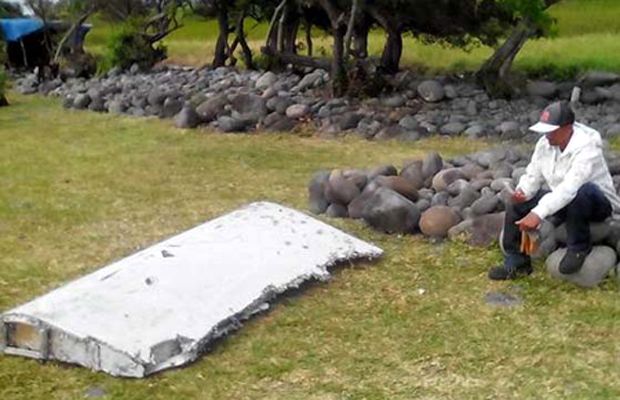Washington: Air safety investigators have a “high degree of confidence” that aircraft debris found in the Indian Ocean is of a wing component unique to the Boeing 777, the same model as the Malaysia Airlines plane that disappeared last year, a US official said Wednesday.
Air safety investigators – one of them a Boeing investigator -have identified the component as a “flaperon” from the trailing edge of a 777 wing, the US official said.
A French official close to an investigation of the debris confirmed Wednesday that French law enforcement is on site to examine a piece of airplane wing found on the French island of Reunion, in the western Indian Ocean. A French television network was airing video from its Reunion affiliate of the debris. US investigators are examining a photo of the debris.
The last primary radar contact with Malaysia Airlines Flight 370 placed its position over the Andaman Sea about 230 miles northwest of the Malaysian city of Penang. The French island of Reunion is about 3,500 miles (5,600 kilometres) southwest of Penang, according to a Google map.
The US and French officials spoke on condition that they not be named because they aren’t authorized to speak publicly.
At the United Nations, Malaysian Transport Minister Liow Tiong Lai told reporters that he has sent a team to verify the identity of the plane wreckage.
“Whatever wreckage found needs to be further verified before we can ever confirm that it is belonged to MH370,” he said.
The discovery is unlikely to alter the seabed search, said Australian Transport Safety Bureau Chief Commissioner Martin Dolan, who is heading up the search effort in a remote patch of ocean far off the west coast of Australia. If the find proved to be part of the missing aircraft, it would be consistent with the theory that the plane crashed within the 46,000 square mile (120,000 square kilometer) search area, 1,100 miles (1,800 kilometers) southwest of Australia, he said.
“It doesn’t rule out our current search area if this were associated with MH370,” Dolan told The Associated Press. “It is entirely possible that something could have drifted from our current search area to that island.”
Dolan said search resources would be better spent continuing the seabed search with sonar and video for wreckage rather than reviving a surface search for debris if the find proved to be from Flight 370.
If the debris turns out to be from the missing aircraft, it will be the first confirmation that the plane crashed into the Indian Ocean after it vanished on March 8, 2014, with 239 people on board while traveling from Kuala Lumpur, Malaysia, to Beijing. A massive multinational search effort of the southern Indian Ocean, the China Sea and the Gulf of Thailand turned up no trace of the plane.
Confirmation that the debris came from Flight 370 would also finally disprove theories that the airliner disappeared somewhere in the northern hemisphere, Dolan said.
It was well understood after the aircraft disappeared that if there was any floating debris from the plane, Indian Ocean currents would eventually bring it to the east coast of Africa, said aviation safety expert John Goglia, a former member of the U.S. National Transportation Safety Board. But the debris is unlikely to provide much help in tracing the oceans currents back to the location of the main wreckage, he said.
“It’s going to be hard to say with any certainty where the source of this was,” he said. “It just confirms that the airplane is in the water and hasn’t been hijacked to some remote place and is waiting to be used for some other purpose. … We haven’t lost any 777s anywhere else.”
Robin Beaman, a marine geologist at Australia’s James Cook University, said there is precedence for large objects traveling vast distances across the Indian Ocean. Last year, a man lost his boat off the Western Australia coast after it overturned in rough seas. Eight months later, the boat turned up off the French island of Mayotte, west of Madagascar – 4,600 miles (7,400 kilometers) from where it disappeared.
“I don’t think we should rule anything out, that’s for sure,” Beaman said. “The Indian Ocean is a big ocean, but the fact that a boat can go that distance and still be recoverable on the other side of the ocean … the possibilities are there.”
Beaman believes experts could analyze ocean currents to try and determine where the plane entered the water, though given the time that has elapsed and the vast distance the debris may have traveled, it would be very difficult.
If the part belongs to Flight 370, it could provide valuable clues to investigators trying to figure out what caused the aircraft to vanish in the first place, said Jason Middleton, an aviation professor at the University of New South Wales in Sydney. The nature of the damage to the debris could help indicate whether the plane broke up in the air or when it hit the water, and how violently it did so, he said.
The barnacles attached to the part could also help marine biologists determine roughly how long it has been in the water, he said.
A comprehensive report earlier this year into the plane’s disappearance revealed that the battery of the locator beacon for the plane’s flight data recorder had expired more than a year before the jet vanished. However, the report said the battery in the locator beacon of the cockpit voice recorder was working.
Investigators hope that if they can locate the two recorders they can get to the bottom of what has become one of aviation’s biggest mysteries. The unsuccessful search for Flight 370 has raised concern worldwide about whether airliners should be required to transmit their locations continually via satellite, especially when flying long distances over the ocean.
Apart from the anomaly of the expired battery, the detailed report devoted page after page to describing a flight that started off completely normal.
The 584-page report by a 19-member independent investigation group went into minute details about the crew’s lives, including their medical and financial records and training. It also detailed the aircraft’s service record, as well as the weather, communications systems and other aspects of the flight. Nothing unusual was revealed.
The 777, first introduced into service in 1995, had had an enviable safety record up until Flight 370. The only prior fatal crash was of an Asiana Airlines flight while landing in San Francisco in 2013 that was later attributed by accident investigators to mistakes by the flight’s pilots. Two passengers were killed in the crash and a third was run over by a rescue truck responding to the scene.
Four months after the disappearance of Flight 370, another Malaysia Airlines 777 was shot down over a rebel-held portion of Eastern Ukraine, killing all 298 aboard.
Malaysia Airlines says ‘premature’ to speculate on wreckage
Malaysia Airlines cautioned on Thursday that it was “premature” to speculate on whether aircraft wreckage found in the Indian Ocean was from missing flight MH370, as authorities scrambled to verify the origin of the debris.
The two-metre (six-foot) long piece of wreckage, possibly from a wing part known as a flaperon, was found on a beach on the French island of La Reunion.
“At the moment, it would be too premature for the airline to speculate (on) the origin of the flaperon,” Malaysia Airlines said in an emailed statement.
It said it was working with “relevant authorities to confirm the matter”.
Earlier, Malaysian Transport Minister Liow Tiong Lai said in New York his government had sent a team to examine the find, while also cautioning against jumping to conclusions.
The plane vanished at night over the South China Sea after mysteriously diverting from its north-bound route from Kuala Lumpur to Beijing with 239 people on board.
Authorities involved in an Australian-led search believe it went down in the southern Indian Ocean.
But no physical evidence of the wreckage has ever been found in one of aviation’s great mysteries, and Malaysian authorities in January declared that all on board were presumed dead.
Malaysia’s Department of Civil Aviation Director-General Azharuddin Abdul Rahman told AFP his agency would meet on Thursday with the country’s transport ministry, foreign ministry, and Malaysia Airlines to discuss “next steps”.
“But first we need to verify whether this part belongs to MH370. We have to look at it,” he said.
Malaysian authorities could not offer an estimate of when experts might be able to definitively determine whether the part is from MH370.
Malaysia is overall coordinator of an investigative effort that includes Boeing, the US National Transportation Safety Board, and other agencies.
The initial search for MH370 was marked by a series of false leads and contradictory statements by Malaysian authorities, and the news of the discovery stirred painful emotions in next of kin frustrated by the lack of evidence.
“We have been on the roller coaster many times and have managed to settle, but now this,” said Jacquita Gonzales, whose husband Patrick Gomes was the flight’s cabin crew supervisor.
“We have mixed feelings. If this is true, at least I know I can have peace and give my husband a proper send-off. But part of us still hopes they are out there alive somewhere.”



